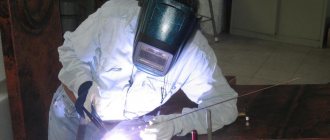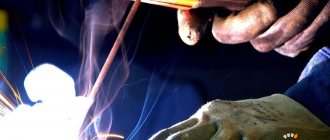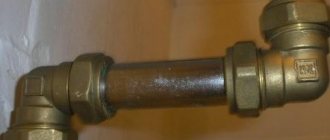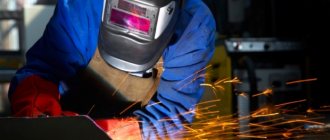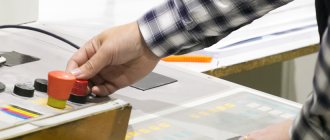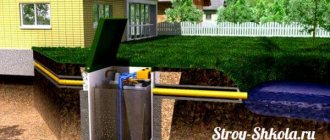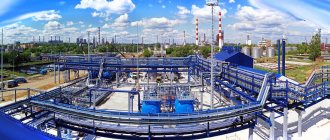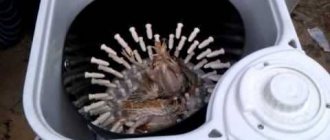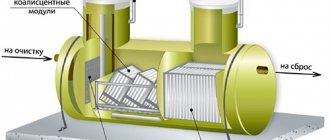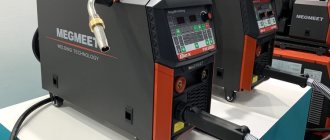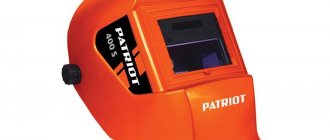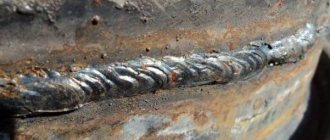Exam tests for welders with answers
The correct answer is marked with a + sign
1. How are the properties of a welded joint determined?
+ Properties of the weld metal, fusion line with the base metal and heat-affected zone
— Technical characteristics of the electrodes used
— Metal properties of the fusion line and heat-affected zone
2. What is the purpose of cutting edges?
— To save metal
— For more convenient welding work
+ To ensure penetration to the full depth
3. Correction of through defects in welded joints of pipeline fittings is carried out by cutting the edges. Specify acceptable edge opening angles.
+ 65-75 degrees
— 15-20 degrees
— 30-45 degrees
4. Decipher the meaning of the electrode markings: the letter “E” and the following digital value.
— Electrode type and permissible number of hours of use
+ Type of electrode and guaranteed tensile strength of the deposited metal per kgf/mm2
— Electrode brand and serial number assigned by the manufacturer
5. What should be the characteristics of power sources for manual arc welding or surfacing with coated electrodes?
— Variable
+ Steep or rigid (in combination with ballast rheostats)
— Bottom-up controlled
6. In what order is welders certified?
— By decision of the certification commission
— First the theoretical part of the exam, and then the practical
+ First the practical part of the exam, then the theoretical part
7. Indicate the correct marking that would indicate the thickness of the coating in the electrode designation.
+ Thin coating - M, medium coating - C, thick coating - D, extra thick coating - G
— Without coating — TO, medium coating — SR, thick coating — TL, extra thick coating — OTL
— Without coating — BP, thin coating — T, medium coating — C, thick coating — TT, extra thick coating — TTT
8. Which drawing shows a visible weld?
9. When performing manual arc welding, lack of penetration occurs due to:
+ High speed of work, insufficient welding current
— Low speed of work, excessively high welding current
— Incorrect selection of electrodes, excessively high welding current
test 10. Define the concept of “electroslag welding”.
— Electric current welding, in which a by-product of metal melting is a layer of flux that can be reused in electric arc welding
+ Fusion welding, in which the heat generated when an electric current passes through masses of molten slag is used for heating
— Fusion welding, which uses strip electrodes and a layer of slag as a cooling medium
11. The ultrasonic testing method allows you to identify the following weld defects:
— Quality of metal melting
+ Lack of penetration, cracks, pores, inclusions of metallic and non-metallic nature, lack of fusion
— Internal metal stresses
12. The maximum length of the flexible cable used to connect the mobile electric welding unit to the switching device is:
— 25 m
— 20 m
+ 15 m
13. The design characteristics of edge cutting are:
+ Blunting, bevel angle
— Metal melting temperature, welding depth
— Angularity, edge bevel angle
14. Residual welding deformations are:
— Deformations that are associated with defects in the electrodes
+ Deformations that remain after welding is completed and the product has completely cooled
— Deformations formed after exposure to a short-term mechanical load on the welded joint
15. What weld defect is shown in the figure?
— Non-fusion
+ Lack of penetration
— Incorrect edge cutting
16. Burns are formed due to:
+ Inconsistencies between the welding current and the thickness of the elements being welded
— Incorrectly selected electrodes
— Incorrect size of weld pool
17. Indicate the optimal method for preventing the formation of hot cracks during welding.
— V-shaped edge groove
+ Selecting the correct edge cutting shape, reducing heat input
— Carrying out heat treatment of metal before welding
18. Quality control of welded joints is checked by:
+ Properties of the weld metal, fusion line with the base metal and heat-affected zone
— Appearance of the weld leg
— Weld color
19. The appearance of a fracture in a welded joint allows you to determine:
— Strength, corrosion resistance, deformation resistance
+ The structure and structure of the metal, which is valuable information for assessing its plastic properties
— Presence of harmful impurities in the metal
test-20. List the types of welded joints.
+ Butt, tee, corner, overlap
— Flat, corner, butt, volumetric
- With overlap, without overlap
21. Describe the principle of grounding welding equipment.
— A copper wire is welded to the equipment. The inscription “Earth” is required
— The equipment has a special clamp located in an accessible place. The presence of the inscription “Earth” is optional
+ The equipment has a bolt with a pad surrounding it. The inscription “Earth” is required
22. The influence of heating the product during the welding process on the amount of residual deformation is expressed in:
— Increase in these deformations
+ Reducing these deformations
— No influence
23. Magnetic arc blowing is:
— Increase in the linear dimensions of the arc due to the influence of the magnetic field of the metal being fused
+ Deviation of the arc from the axis of the electrode, resulting from the influence of magnetic fields or ferromagnetic masses during welding
— Increased penetration of the product due to the influence of the magnetic field of the arc
24. When is it possible to correct defects in welded products subject to subsequent tempering (heat treatment)?
+ Before vacation
— After vacation
— As defects are discovered
25. Welded wires Sv-08, Sv-08a, Sv-10GA belong to the ... class of steels.
— Alloyed
— Highly alloyed
+ Low carbon
26. Methods for monitoring the degree of impact on the material of a welded joint are:
+ Destructive and non-destructive
— Radiographic and ultrasound
— Static and dynamic
27. State the purpose of co-heating and preheating.
— Increasing the carbon content in the metal
+ Leveling out uneven heating during welding, reducing the cooling rate and reducing the likelihood of cold cracks
— Increasing the metal cooling rate in the welding zone
28. Sagging in weld metal is:
— Roughness of the metal, affecting the operational and aesthetic characteristics of the welded product
+ A defect in the form of metal that has floated onto the surface of the metal being welded or a previously made roller and has not fused with it
— Deviation of the linear dimensions of the seam from the reference ones (assigned in the drawings)
29. The numbers next to the letters on the drawing of the weld indicate:
+ Sequence number of the seam in accordance with GOST
— Preferred electrode thickness for work
— Length of the seam leg
test_30. Requirements for the quality of the repaired seam section:
— Determined individually by the acceptance group
+ Similar to those required for the quality of the main seam
— Are recorded in regulatory documents and depend on the type of seam
Pass the NAKS training tests for welders and welding specialists
Published by Expert on 04.11.202004.11.2020
How to become a certified welder
Today, without NAKS (National Welding Quality Agency), you cannot get a job in a reputable company. Even if you are a super welder, you must know the theory. You can, of course, enroll and complete welding training courses. From personal experience, I will say that nowadays we don’t teach, but teach and work out the required hours of the program. Whether you have learned it or not is your problem. Most likely, you will be issued a welder's certificate of the required category. But with a certificate without work experience and NAKS certification, a welder can only go to a private owner at a construction site or in a village to weld tracks and seeders.
In order to independently prepare for passing the theoretical part, we post simple tests on the website for specialists of different levels of welding (I-III). The tests are really ancient (10 years) and some references in the tests point to documents that are no longer valid. But the questions and comments themselves are relevant. In our digital age, it is not difficult to find any document of the old and new editions, because mainly their names have changed, and not the internal essence.
How to work with tests.
- Click on the link and download the small file to your computer.
2. Open the self-extracting archive
3. Click on the file to be launched with the EXE extension
4. Enter your data (you can use any data for formality)
5. Answer test questions on the topic
6. Look at the result and comments on errors
It's that simple. The tests were checked for viruses by the licensed program “Avast Premium Security” and the Yandex Disk server antivirus
Test on general questions of the metal welder and polyethylene welder exam
Test on general questions of the welding specialist exam level II-III
Groups of basic materials used in the manufacture, installation, repair and reconstruction
of boiler equipment (BO)
Test for welders of boiler equipment (KO 1-5) welding of RD and RAD
Test for welding specialists KO1-5
Groups and brands of basic materials used in the manufacture, installation, repair and reconstruction
of gas equipment (GO)
Welding test for welders GO1-7
Test for welding production specialists in civil engineering
Groups and typical brands of basic materials used in the manufacture, installation, repair and reconstruction of material handling equipment (H&T)
Test for VET welders
Test for level II-III welding specialists (WET)
Groups and typical brands of basic materials used in the manufacture, installation, repair and reconstruction of oil and gas production equipment.
Test for welders (NGDO)
Test for level II-III welding engineer (NGDO)
Groups and typical brands of basic materials used in the manufacture, installation, repair and reconstruction of metallurgical equipment.
Test for a welder of metallurgical equipment (MO)
Groups and typical grades of basic materials used in the manufacture, installation, repair and reconstruction of mining equipment (GDO)
Test for GDO welder
Test for a welding specialist of II-III level GDO
Groups and typical grades of basic materials used in the manufacture, installation, repair and reconstruction of steel structures (SK)
Test for steel structure welder (SW)
Test for welding specialist level II-III
Equipment for chemical, petrochemical, oil refining and fire and explosion hazardous industries (OHNVP)
Test for welding engineers of high pressure equipment
We hope our tests will help you. Good luck in your work and mastering the complex but necessary profession of a welding specialist of levels I-III!
What does NAKS welder certification provide?
The National Welding Control Agency carries out certification activities in relation to specialists and welders who are involved in welding production at hazardous production facilities.
Based on the results of the certification, the person who passed it is issued a special certificate, which indicates the assigned qualification level, as well as the types of work that a specialist or welder is authorized to perform.
The issuance of such a certificate occurs after passing the entire certification procedure at a certification center or a special certification point, which is authorized to carry out such activities by the National Welding Control Agency.
(semi-automatic welding)
Now we will talk about how to make welds using a semi-automatic machine if you are welding critical structures or are going to submit them under control for NAKS certification.
Here's how this is done using the example of two workpieces (plates) 12 mm thick, butt welded in a vertical position using a SKYWAY 330 inverter.
The plates need to be prepared: cut using a plasma cutter or grinder.
Also, for the correct progress of work you will need: • lead strips (2 pcs.) - necessary for starting and finishing welding, since it is difficult to obtain a high-quality seam at these stages. The strips are technological and subsequently cut off;
• devices that prevent reverse bending of our blanks (2 pcs.);
• a template for controlling the gap (any piece of hardware that allows you to set the gap, in our case 2 mm).
In order to properly prepare our connection for further welding work, you need to familiarize yourself with the requirements of GOST 5264-80 (click to download page with text). Look for the compound you will be working with, in our version it is C17. GOST specifies how to prepare this connection: you need to bevel the edges at an angle of 30° and blunt them. The plates must be cleaned of oxides, dirt and rust at a distance of at least 10 mm from the boundaries of the future weld.
For proper assembly, it is convenient to use a magnetic square. It will align the plates relative to each other and prevent them from moving during the process of tack placement.
Magnetic square
We control the two-millimeter gap with a template, the role of which can be played by any suitable piece of metal. Attach the template to the place where you intend to start welding and set the gap exactly according to it. At the end of the weld, the gap needs to be slightly increased, due to the fact that the plates will be pulled together during the crystallization of the deposited metal.
Next, a device is installed to prevent bending and tightening of the workpieces. They grab one device, then control the displacement and set the gap, as was said, a little more than 2 mm, for example, 2.2 ... 2.3 mm. Then they place spot tacks on the second “fixture”.
Prisp-I, preventing deformation of plates, stuck points
After you have installed the tacks, you need to see if the plates have moved. To do this, you can use the same template to set the gap. If it has a smooth edge, it can be used to control how evenly the plates being welded are aligned relative to each other - simply apply the smooth edge to the joint and see that there are no gaps.
Checking the offset with a template
If such are found, at this stage you can always straighten it with a hammer or other special tools. devices.
Now you can weld a continuous seam. We put on gloves, a mask, and arm ourselves with a semi-automatic burner. You don’t need to scald it too much, because the devices against bending of the workpieces perform a technological role and they will need to be knocked out.
Welding lead strips
The preparation of the planks is the same as for the base metal. The edges are beveled; their thickness must also correspond to the thickness of the structure being welded. They are installed on tacks.
Lead strip tacked to the base metal
In order to increase the level of complexity of the task, it is better for the welder to perform a vertical seam of the connection, this will allow him to fully test his skills and abilities. It is also necessary to correctly set the welding parameters on the SKYWAY 330 power source. The parameters can be adjusted through trial and error. In our case, for a workpiece thickness of 12 mm, the following welding mode was selected: U = 17V; Vfeed = 3 meters; Uadjusted=-5; L=0, where L is inductance. Consumables (they are optimal for the given case): Electrode wire Ø1 mm; Gas mixture 82% Ar+18% CO2.
According to the rules, in order to avoid hydrogenation of the weld, which leads to the appearance of pores, the plates must be heated to T = 100 ... 120 °C. Rules are just rules, to be circumvented. Undoubtedly, pores represent seam defects and are a rejection sign. However, it should be assumed that during the passage of the seam, the moisture present on the surface of the metal will immediately evaporate. After all, no one thinks of preheating the wire before welding. However, if you are taking the NAKS certification exam, you should know about the existence of such an operation - this is a mandatory requirement. In industrial conditions, the operation can be performed in an oven, in other cases - using an oxy-acetylene torch or torch.
How is the verification process carried out?
Certification, including level 3 NAKS certification and level 4 NAKS certification, can be primary. This check must be carried out by those people who do not yet have certificates. A repeat inspection is scheduled to confirm knowledge, an extraordinary inspection is scheduled if any problems or doubts arise about the welder’s professionalism. To pass the exam, you must submit an application, submit a medical certificate, an extract from your work record book, educational documents, documents confirming completion of safety training, and a 3 by 4 cm photo.
The qualifying exam begins with a practical part. If it is not passed, you can retake it in a month. Then a general and special exam is conducted. On it, a specialist demonstrates his ability to perform welding operations. The exam is conducted in the region where the specialist lives. The commission includes an employee of Rostechnadzor, as well as an employee of the certification center.
